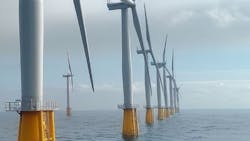Control system improves stability of subsea robots for offshore wind maintenance
Engineers at the University of Edinburgh in Scotland have conducted trials of underwater autonomous robots that could predict waves in real time.
They are designed for stable operations in turbulent offshore waters, and could potentially support safer and faster maintenance of offshore wind farms and tidal turbines, the team claims.
Hitherto, the unpredictable nature of waves has limited the use of offshore robots for platform maintenance offshore, as it impacts their ability to remain stable and perform precise movements.
Successfully stabilized robots, however, could simplify tasks involving ships and helicopters or hoisting equipment out of the water, removing the need for people to work in hazardous situations.
The university’s engineers developed new computational and experimental tools to allow autonomous robots to maintain a steady position while being buffeted by irregular waves.
They trialled their system at the University of Edinburgh’s FloWave testing tank, using wave data taken by a buoy in the North Sea to simulate the conditions the robots might work in.
Wave-detecting devices tethered to the seafloor and measuring the direction and height of incoming waves relay these details in real-time to a robot working nearby. Using this information, the robot could address complex disturbances in the water to maintain itself in a stable position.
Results so far suggest the system could be compatible with robots operating both near the surface and at greater depths, where disturbances can be strongest.
The technology is also said to represent an advance on conventional control systems which operate in a corrective fashion and tend to respond slowly to fast-changing disturbances in the ocean.
Dr Kyle Walker said current robots’ ability to perceive and counteract environmental disturbances effectively restricts the use of small subsea vehicles. “By forming a prediction of future wave disturbances and integrating this within the control system, we're able to expand this range with little to no change to the robot hardware.
“In terms of translating this technology into the field, this is a huge benefit and makes our system applicable to most vehicles currently available on the market.”
Future research will look to improve autonomous machines’ ability to perform tasks such as the use of robotic arms to detect rust or fix electric equipment while maintaining a steady position in water.
The study received funding from the Engineering and Physical Sciences Research Council and was a continuation of the now-completed ORCA Hub green energy project led by Heriot-Watt University and the University of Edinburgh.
